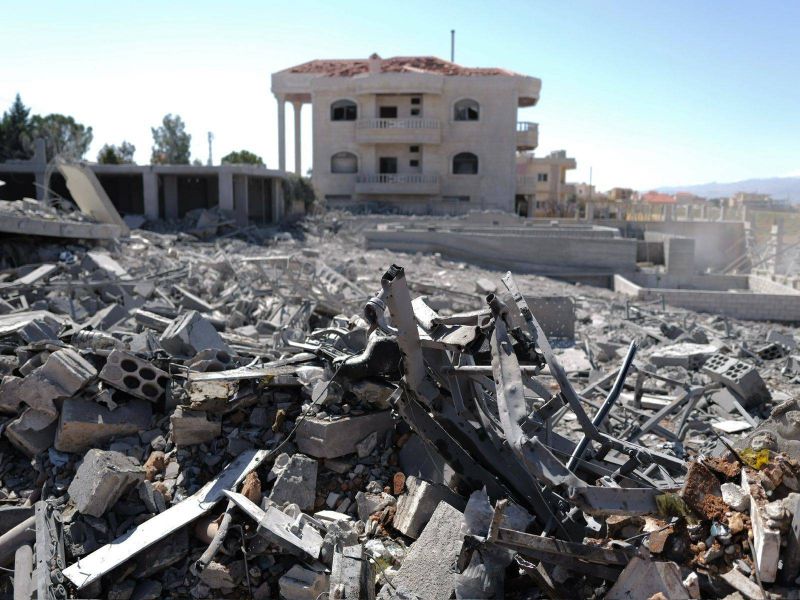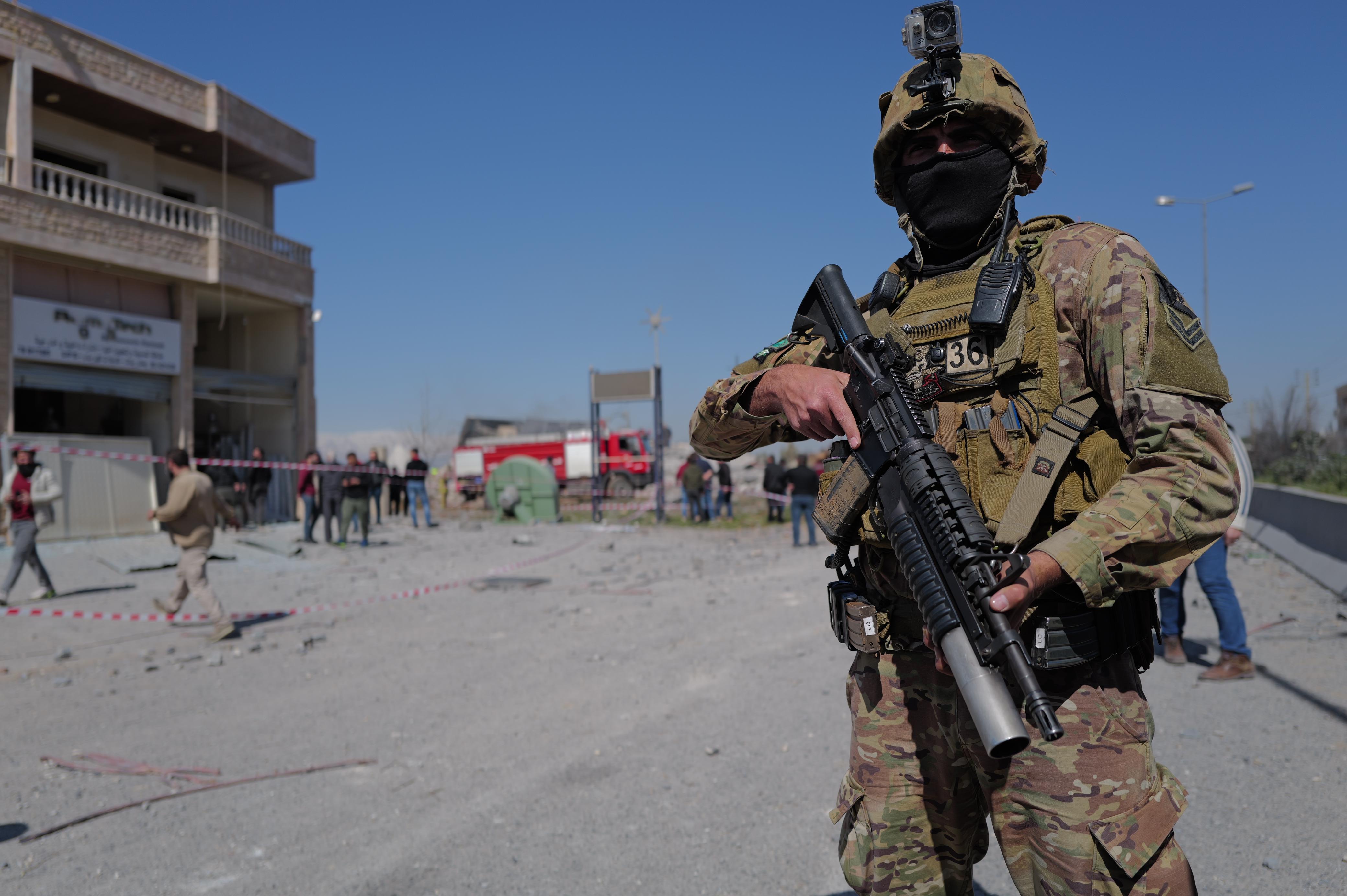
The building destroyed in al-Ansar, March 12, 2024. (Credit: Matthieu Karam/L'Orient-le Jour)
While cross-border fighting between Hezbollah and Israel has largely been contained to the land south of the Litani River, the Bekaa Valley in eastern Lebanon was struck four times by the Israeli army in the last 24 hours and, possibly, if not for a malfunction, could have been struck a fifth.
This is the second time since the war between the two sides began on Oct. 8, one day after the unprecedented Hamas-led attack on southern Israel, that the Bekaa has been targeted. At the end of February, an Israeli airstrike there cause an outcry among residents there and fears across the country of an escalation in its wake.
On Monday evening, the Israeli air force struck the Baalbeck region twice, killing one civilian and wounding several others. It then struck again early Tuesday morning killing another person and wounding six others. In between the two strikes, Hezbollah announced that it had fired more than 100 Katyusha missiles at the "Israeli air and missile defense command headquarters in the Kila barracks, the Yoav missile and artillery base and nearby artillery launchers" in response to the previous night's raid.
By a disturbing coincidence, mid-afternoon on Monday, the Israeli army's Arabic-speaking spokesperson, Avichay Adraee, had mentioned Baalbeck in a post on the social media platform X, addressing the Lebanese actor Ali Etihad, a native of the region, who had himself warned the Israeli government through social media that "striking Baalbeck" would be tantamount to taking the war to the next level.
"Baalbeck is no more important than Kiryat Shmona, Metulla and all the border areas in the north [of Israel]. The Iranian aggressor, represented by Hezbollah and stationed in Baalbeck, is solely responsible," wrote the Israeli spokesperson.
Strikes 1 and 2
Within 24 hours, Israel had targeted a timber warehouse between the villages of Shmustar and Taraya, in the Baalbek-Hermel district, and a two-story building in Ansar, just a couple kilometers from the ancient Roman ruins of Baalbeck, host to one of the largest Roman temples.
The attack on the two-story building killed Moustafa Gharib, a soccer player with the local club “Shabab Baalbeck,” and injured at least six other people. Gharib and two other people, including the son of the director of Dar al-Salam Hospital, located nearby, were on the roof of the house belonging to the Alam family when the strike took place.
L’Orient-Le Jour’s Matthieu Karam and Emmanuel Haddad visited the site of the strike Tuesday and witnessed the damage caused by Monday’s raids. The roof of the building had collapsed and beneath the rubble were crumbled cinderblocks, barrels of olive oil, hospital beds, and the shells of cars. The timber warehouse had served many purposes. Hezbollah members secured the site of the strike with a yellow ribbon.
"This building housed an olive oil factory, offices of the Ministry of Industry and a warehouse of the Dar al-Amal hospital," explained a Hezbollah source who accompanied our journalists to the scene.
Oil dripped from the first floor’s shattered windows. On the second floor, sofas had been ripped open. On the roof, the hospital director’s son, Mahmoud Alam had set up a table and chairs; the soccer team often gathered on the roof to spend evenings together. A hundred meters away, Mahmoud's house was blown up. Everyone injured in the strike were taken to Dar al-Salam Hospital.
On the second floor of the hospital, Abdel al-Majid, a Syrian man from Homs, lay on a bed with his arm bandaged. He had been at home when the olive oil factory was hit, just fifty meters away. "I heard a terrible noise, and suddenly I saw my arm bleeding. I came out of my house and saw a horrific scene. The strike was so powerful that pieces of Mahmoud's house, on the other side of the road, had landed at my house," he recalled. All the other survivors of the strike had been treated and sent home. Only Abdel al-Majid is still hospitalized, along with his brother. "He has lost an eye, but doesn't know it yet," said a hospital employee.
According to the Israeli army spokesperson, the strike targeted a center used by Hezbollah to carry out air strikes. "Do you see any weapons here?" a Hezbollah member replied, standing in front of the charred hospital beds.
"We are not positioned near civilian areas," he assured. Sifting through the debris, Hezbollah members pointed out documents stamped by the Ministry of Industry. "We can't replace the state, building shelters for civilians, but we ask people in high-risk areas to leave their windows open and stay away from them,” the Hezbollah source said, referring to the precautionary measure meant to prevent glass window panes from shattering during explosions.
 The army secures the premises on the Safari road in the Baalbeck region. (Credit: Matthieu Karam/L'Orient-le Jour)
The army secures the premises on the Safari road in the Baalbeck region. (Credit: Matthieu Karam/L'Orient-le Jour)
Hezbollah refused to take L’Orient-Le Jour’s team to the site of the second strike in Taraya, referring vaguely to “the presence of missile debris.”
Hezbollah took time reacting to the Baalbeck strikes. In the mid-morning, it announced that at 7 a.m. it had fired over 100 Katyusha missiles at the "Israeli air and missile defense command headquarters in the Kila barracks, the Yoav missile and artillery base and nearby artillery launchers."
In its statement, it said that the attack had been launched in response to the Israeli attack on Baalbeck on Monday night — its first official reaction since the attack. The Israeli army reported on its own strikes via Avichay Adraee's X account.
Strikes 3 and 4
Around noon on Tuesday, the district of Baalbeck was targeted again. Israeli warplanes conducted a raid on the Bekaa, L’Orient Today’s correspondent in the region, Sarah Abdallah reported.
The air raid specifically targeted the Sfari road, which leads to the city of Baalbeck. Shortly after the attack, ambulances rushed down that road to the strike. Then the army cut off the road while firefighters and members of the Civil Defense battled a fire still raging there. Columns of smoke were still rising from the piles of rubble which had once been a plastic factory when Karam and Haddad arrived to the scene. The road was covered with debris and the smell of sulfur filled the air. Lebanese Army special forces secured the area while construction vehicles worked to help around 20 rescue workers dig for survivors under the broken concrete.
First responders gathered on the smoking roof with stretchers, waiting to receive casualties. Later, Abdallah reported that she’d been informed by a security source of one death and six injuries from the strike.
In the sky, warplanes circled over the snowy peaks of Anti-Lebanon Mountains. Not long after, another Israeli air strike targeted a three-story building on the outskirts of the village of Nahi Sheet, Baalbeck district, in the Bekaa Valley.
A resident of the village pointed to a building in the distance, the second floor of which had been carved out by the strike. He told L’Orient-Le Jour’s team that someone had been wounded in the house, which he asserted was home to residents of Nabi Sheet and nothing else.
Israeli missile falls in Kesrouan
Meanwhile, high above the valley and to the west, an Israeli missile landed in the Lebanese village of Hrajel, three kilometers west of the popular skiing destination of Faraya. The missile landed on Tuesday without exploding or causing any casualties, Tony Zoughaib, the Chairman of Hrajel’s Municipal Council told L'Orient-Le Jour.
The elected official claimed that the missile had been linked to a drone that “obviously fell by mistake in the village, as it was heading towards the Bekaa for a raid."
Zoughaib said the missile fell on “undeveloped land” in the Saoumaha district of the Christian village in Kesrouan. Its landing spot was about 50 meters from the main road at the entrance of the village and surrounded by houses. There were no casualties and no damage.
The incident caused a stir among the local population. Since Oct. 7, the 1,300-meter-high region of Mount Lebanon has seen daily air traffic by Israeli reconnaissance and observation aircraft. "We regularly hear the noise of Israeli planes. But this time, we heard a loud whistle before the missile fell. And let me tell you, the population was scared,” Zoughaib recalled.
The army and relevant departments quickly arrived on the scene, cordoned off the area surrounding the weapon and kept the site clear of people, Zoughaib said, adding that he was still hoping to receive more information.
This article originally appeared in French on L’Orient-Le Jour. Translated to English by Amelia Hankins.
